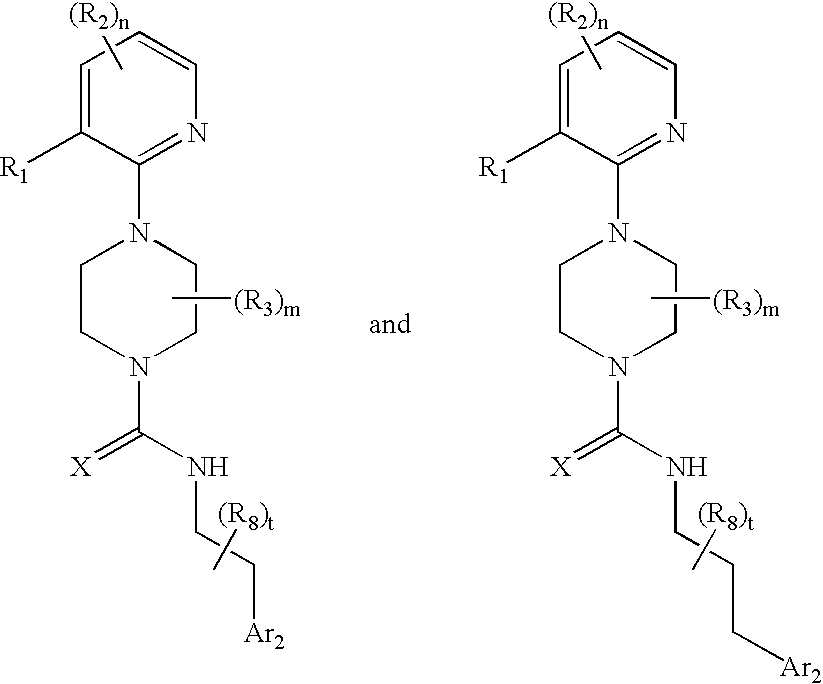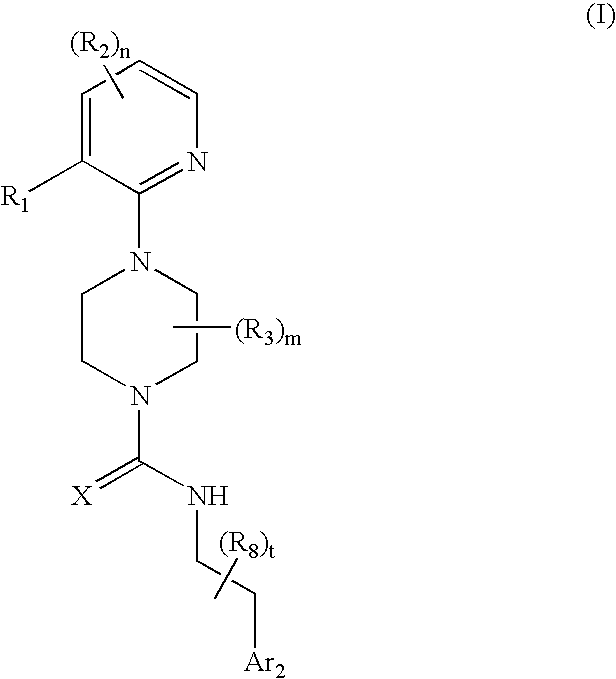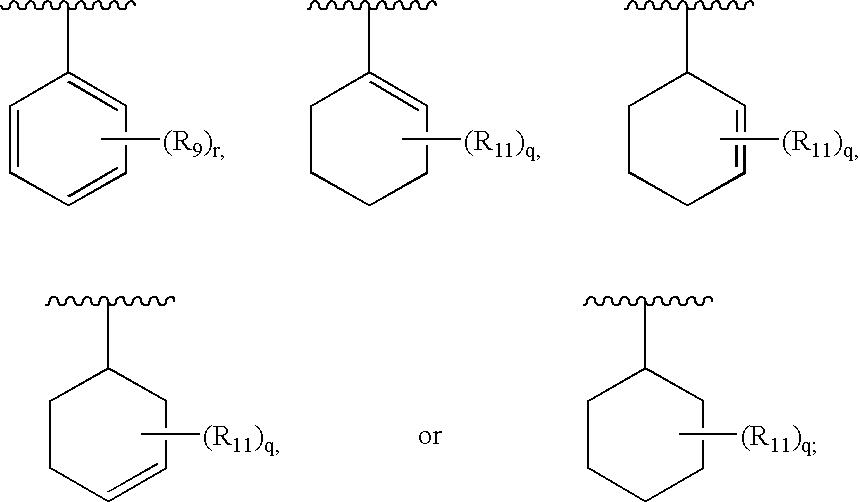Therapeutic agents useful for treating pain
- Summary
- Abstract
- Description
- Claims
- Application Information
AI Technical Summary
Benefits of technology
Problems solved by technology
Method used
Image
Examples
example 1
5.1 Example 1
Synthesis of Compound A19
[0338]
[0339] To a solution of 0.1 g (0.43 mmol) of compound 1 (commercially available from Maybridge Chemical Company Ltd., UK) in DCM (5 mL) was added 0.063 g (0.43 mmol) of phenethylisocyanate 2 (commercially available from Sigma-Aldrich, St. Louis, Mo. (www.sigma-aldrich.com)) and the resulting reaction mixture was stirred for about 4 h. at about 25° C. The solvent was removed under reduced pressure to provide a residue that was purified using a silica gel column eluted with a gradient of 20:80 ethyl acetate:hexane to 50:50 ethyl acetate:hexane to provide 3-substituted Pyridyl Compound A19 as a white solid (140 mg, 86% yield).
[0340] The identity of Compound A19 was confirmed using 1H-NMR spectroscopy and mass spectrometry (MS).
[0341] Compound A19: 1H-NMR (400 MHz, CD3OD): δ 2.85(t, 2H), 3.32 (bm, 4H), 3.52-3.65 (m, 6H), 4.55 (bs, 1H), 7.05 (t, 1H), 7.21 (bm, 3H), 7.63 (t, 2H), 7.93 (t, 1H), 8.49 (d, 1H).
[0342] MS (EI): m / z 378 (m+1).
example 2
5.2 Example 2
Synthesis of Compound A57
[0343]
[0344] To a solution of 0.1 g (0.53 mmol) of compound 3 in DCM (5 mL) was added 0.078 g (0.53 mmol) of phenethylisocyanate 2 (commercially available from Sigma-Aldrich, St. Louis, Mo. (www.sigma-aldrich.com)) and the resulting reaction mixture was stirred for about 4 h. at about 25° C. The solvent was removed under reduced pressure to provide a residue that was purified using a silica gel column eluted with a gradient of 20:80 ethyl acetate:hexane to 50:50 ethyl acetate:hexane to provide 3-substituted Pyridyl Compound A57 as a white solid (150 mg, 84% yield).
[0345] Compound 3 was obtained by dissolving 5 g of 2-chloro-3-cyano-pyridine (commercially available from Sigma-Aldrich, St. Louis, Mo. (www.sigma-aldrich.com)), 6.21 g of piperazine (72.16 mmol) (commercially available from Sigma-Aldrich, St. Louis, Mo. (www.sigma-aldrich.com)), and 1.25 mL (72.16 mmol) of DIEA in DMF and allowing the resulting reaction mixture to stir for about 15 ...
example 3
5.3 Example 3
Synthesis of Compound A38
[0349]
[0350] To a solution of 0.1 g (0.48 mmol) of compound 4 in DCM (5 mL) was added 0.071 g (0.48 mmol) of phenethylisocyanate 2 (commercially available from Sigma-Aldrich, St. Louis, Mo. (www.sigma-aldrich.com)) and the resulting reaction mixture was stirred for about 4 h. at about 25° C. The solvent was removed under reduced pressure to provide a residue that was purified using a silica gel column eluted with a gradient of 20:80 ethyl acetate:hexane to 50:50 ethyl acetate:hexane to provide 3-substituted Pyridyl Compound A38 as a white solid (145 mg, 85% yield).
[0351] Compound 4 was obtained by dissolving 5 g of 2-chloro-3-nitro-pyridine (commercially available from Sigma-Aldrich, St. Louis, Mo. (www.sigma-aldrich.com)), 8 g of piperazine (94.5 mmol) (commercially available from Sigma-Aldrich, St. Louis, Mo. (www.sigma-aldrich.com)), and 12.21 mL (94.5 mmol) of DIEA in DMF and allowing the resulting reaction mixture to stir for about 15 h. W...
PUM
| Property | Measurement | Unit |
|---|---|---|
| Time | aaaaa | aaaaa |
| Force | aaaaa | aaaaa |
| Chemical shift | aaaaa | aaaaa |
Abstract
Description
Claims
Application Information
 Login to View More
Login to View More - R&D
- Intellectual Property
- Life Sciences
- Materials
- Tech Scout
- Unparalleled Data Quality
- Higher Quality Content
- 60% Fewer Hallucinations
Browse by: Latest US Patents, China's latest patents, Technical Efficacy Thesaurus, Application Domain, Technology Topic, Popular Technical Reports.
© 2025 PatSnap. All rights reserved.Legal|Privacy policy|Modern Slavery Act Transparency Statement|Sitemap|About US| Contact US: help@patsnap.com



